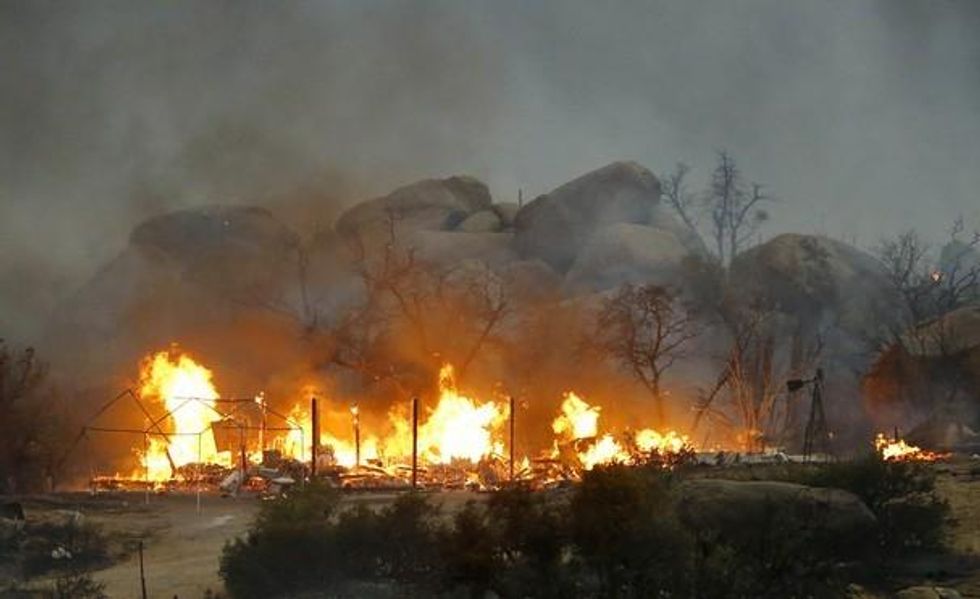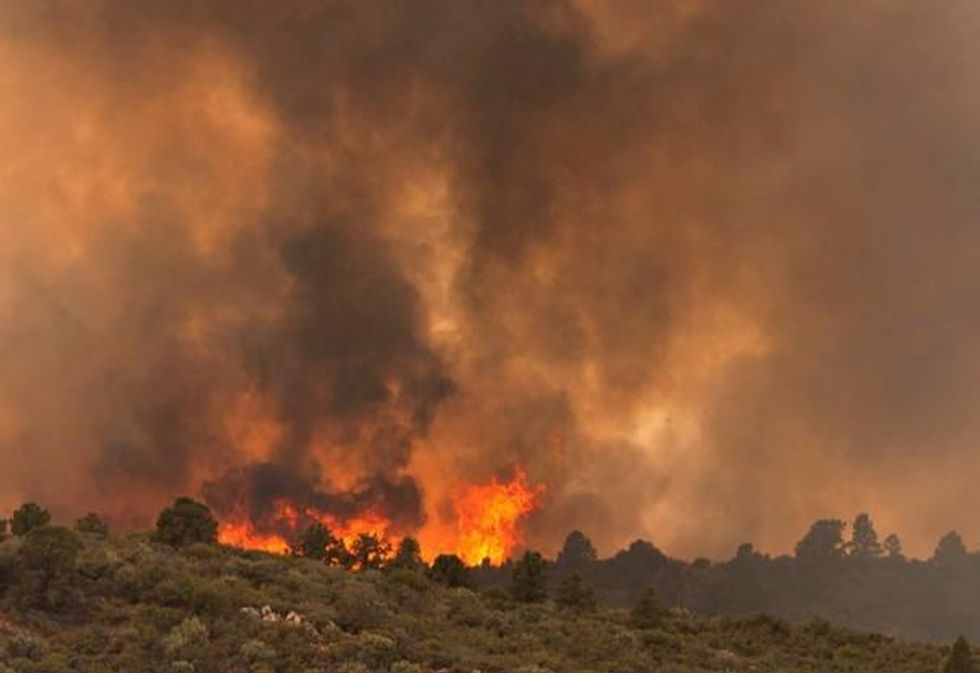

SUBSCRIBE TO OUR FREE NEWSLETTER
Daily news & progressive opinion—funded by the people, not the corporations—delivered straight to your inbox.
5
#000000
#FFFFFF
To donate by check, phone, or other method, see our More Ways to Give page.


Daily news & progressive opinion—funded by the people, not the corporations—delivered straight to your inbox.

Well known as a dangerous job, Sunday's tragedy marks the deadliest wildfire incident involving firefighters in over 30 years, according to the Associated Press.
The men, part of a team from the town of Prescott, Arizona called the Granite Mountain Hotshots, were among the most skilled of the units fighting the fires that have ravaged parts of Arizona and New Mexico in recent weeks.
"We grieve for the family. We grieve for the department. We grieve for the city," said Prescott Fire Chief Dan Fraijo at a news conference Sunday evening. "We're devastated. We just lost 19 of the finest people you'll ever meet."

Explaining the conditions that led to the deaths, AP reports:
Hot shot crews are elite firefighters who often hike for miles into the wilderness with chain saws and backpacks filled with heavy gear to build lines of protection between people and fires. They remove brush, trees and anything that might burn in the direction of homes and cities.
The crew killed in the blaze had worked other wildfires in recent weeks in New Mexico and Arizona, Fraijo said.
"By the time they got there, it was moving very quickly," he told the AP of Sunday's fire.
He added that the firefighters had to deploy the emergency shelters when "something drastic" occurred.
"One of the last fail safe methods that a firefighter can do under those conditions is literally to dig as much as they can down and cover themselves with a protective -- kinda looks like a foil type -- fire-resistant material -- with the desire, the hope at least, is that the fire will burn over the top of them and they can survive it," Fraijo said.
"Under certain conditions there's usually only sometimes a 50 percent chance that they survive," he said. "It's an extreme measure that's taken under the absolute worst conditions."
__________________________________________
Dear Common Dreams reader, The U.S. is on a fast track to authoritarianism like nothing I've ever seen. Meanwhile, corporate news outlets are utterly capitulating to Trump, twisting their coverage to avoid drawing his ire while lining up to stuff cash in his pockets. That's why I believe that Common Dreams is doing the best and most consequential reporting that we've ever done. Our small but mighty team is a progressive reporting powerhouse, covering the news every day that the corporate media never will. Our mission has always been simple: To inform. To inspire. And to ignite change for the common good. Now here's the key piece that I want all our readers to understand: None of this would be possible without your financial support. That's not just some fundraising cliche. It's the absolute and literal truth. We don't accept corporate advertising and never will. We don't have a paywall because we don't think people should be blocked from critical news based on their ability to pay. Everything we do is funded by the donations of readers like you. Will you donate now to help power the nonprofit, independent reporting of Common Dreams? Thank you for being a vital member of our community. Together, we can keep independent journalism alive when it’s needed most. - Craig Brown, Co-founder |

Well known as a dangerous job, Sunday's tragedy marks the deadliest wildfire incident involving firefighters in over 30 years, according to the Associated Press.
The men, part of a team from the town of Prescott, Arizona called the Granite Mountain Hotshots, were among the most skilled of the units fighting the fires that have ravaged parts of Arizona and New Mexico in recent weeks.
"We grieve for the family. We grieve for the department. We grieve for the city," said Prescott Fire Chief Dan Fraijo at a news conference Sunday evening. "We're devastated. We just lost 19 of the finest people you'll ever meet."

Explaining the conditions that led to the deaths, AP reports:
Hot shot crews are elite firefighters who often hike for miles into the wilderness with chain saws and backpacks filled with heavy gear to build lines of protection between people and fires. They remove brush, trees and anything that might burn in the direction of homes and cities.
The crew killed in the blaze had worked other wildfires in recent weeks in New Mexico and Arizona, Fraijo said.
"By the time they got there, it was moving very quickly," he told the AP of Sunday's fire.
He added that the firefighters had to deploy the emergency shelters when "something drastic" occurred.
"One of the last fail safe methods that a firefighter can do under those conditions is literally to dig as much as they can down and cover themselves with a protective -- kinda looks like a foil type -- fire-resistant material -- with the desire, the hope at least, is that the fire will burn over the top of them and they can survive it," Fraijo said.
"Under certain conditions there's usually only sometimes a 50 percent chance that they survive," he said. "It's an extreme measure that's taken under the absolute worst conditions."
__________________________________________

Well known as a dangerous job, Sunday's tragedy marks the deadliest wildfire incident involving firefighters in over 30 years, according to the Associated Press.
The men, part of a team from the town of Prescott, Arizona called the Granite Mountain Hotshots, were among the most skilled of the units fighting the fires that have ravaged parts of Arizona and New Mexico in recent weeks.
"We grieve for the family. We grieve for the department. We grieve for the city," said Prescott Fire Chief Dan Fraijo at a news conference Sunday evening. "We're devastated. We just lost 19 of the finest people you'll ever meet."

Explaining the conditions that led to the deaths, AP reports:
Hot shot crews are elite firefighters who often hike for miles into the wilderness with chain saws and backpacks filled with heavy gear to build lines of protection between people and fires. They remove brush, trees and anything that might burn in the direction of homes and cities.
The crew killed in the blaze had worked other wildfires in recent weeks in New Mexico and Arizona, Fraijo said.
"By the time they got there, it was moving very quickly," he told the AP of Sunday's fire.
He added that the firefighters had to deploy the emergency shelters when "something drastic" occurred.
"One of the last fail safe methods that a firefighter can do under those conditions is literally to dig as much as they can down and cover themselves with a protective -- kinda looks like a foil type -- fire-resistant material -- with the desire, the hope at least, is that the fire will burn over the top of them and they can survive it," Fraijo said.
"Under certain conditions there's usually only sometimes a 50 percent chance that they survive," he said. "It's an extreme measure that's taken under the absolute worst conditions."
__________________________________________